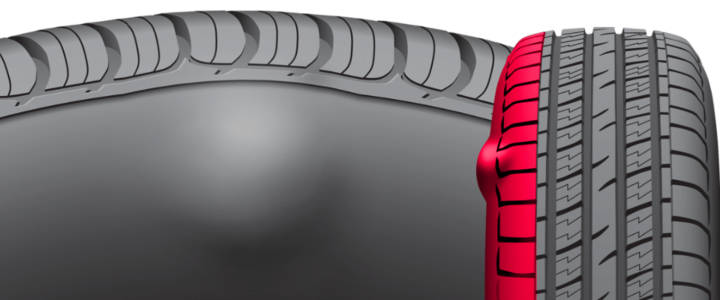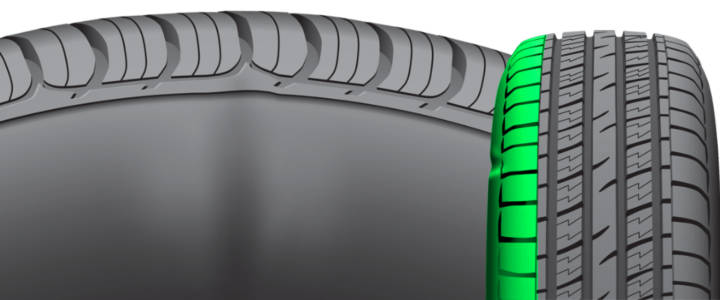INDENTATIONS AND PROTRUSIONS
If you think your tires might have sidewall damage, give them a close inspection. If you notice any of these conditions on your tire's sidewalls, bring them on by your nearest store and we'll give them a look over to make sure they're still in good working order:
- scrapes
- cuts
- gouges
- bulges
- protrusions
When inspecting your tire's sidewall, you may notice sidewall indentations. These are cosmetic and don't pose a safety risk. We understand that sidewall conditions can be difficult to identify. If you have any doubt, bring your ride on by and we'll check your tires out for you!
To give you a better idea of what to look for when inspecting your tire sidewalls, check out our breakdown of the different types of tire sidewall issues below!
SIDEWALL BULGES
A sidewall bulge is a bubble, or protrusion, in the sidewall of a tire.
If we spot a bulge on a new tire, it typically indicates that the tire has a manufacturer defect. Bulges or bubbles are typically caused by a tear in the internal sidewall structure, allowing air to work its way into the sidewall plies, causing the bubble. If your tire(s) have a sidewall bubble, it should be removed from service and sent back to the manufacturer ASAP.
If the bulge appears after time in service, it’s typically a sign of damage within the sidewall plies. This can be caused by hitting anything from potholes or curbs to other road debris. In this case, the sidewall can become pinched, causing a bulge to appear in the tire sidewall. Lower profile tires are more susceptible to sidewall bulges because the shorter sidewall does not flex, or absorb bumps as effectively, as a tire with a taller sidewall.
Sidewall bulges indicate structural damage and can’t be repaired. Since there’s a risk of tire failure, we recommend removing the tire from service immediately. If you install your spare, it is a good idea to deflate the damaged tire before placing it inside your vehicle.
SIDEWALL INDENTATIONS
Picture a balloon with a string tied around the middle of it. If you pull the string tighter, it will create an indentation in the balloon. This is essentially what a sidewall indentation is.
Tires are made up of many layers and each layer has a slight overlap. This overlap reinforces that area of the sidewall. While it makes it stronger, it also prevents it from expanding outward as much as the rest of the sidewall. That’s why indentations are only visible when a tire is mounted and inflated on a wheel.
While it may look unusual, sidewall indentations are no cause for alarm, as they only strengthen that part of the tire. Due to the cause of a sidewall indentation, you can typically find a second indentation on the same spot on the opposite side of the tire. This is also a pretty convenient way to identify a sidewall indentation.
Sidewall indentations are not to be confused with sidewall bulges, which expand outward when the tire is inflated.
SCRAPES, CUTS AND GOUGES
Your tires quite literally do a lot of heavy lifting when it comes to your vehicle. That’s why it’s very common for your tires to sustain some sort of sidewall damage at least once in their service life.
There are a lot of potential causes for scrapes, cuts and gouges. No matter what causes it, if your tire has one of these sidewall conditions, we highly recommend bringing your tires in for an inspection straight away.
Depending on the severity of the damage, the tire may need to be replaced. In the case that the damage isn’t too severe and the tire can still be used, be sure to keep a close eye on the tire, just in case the condition worsens.
If you have any doubts about your tire’s structural integrity, it’s best to play it safe and remove the tire from service.
And if you require new tires, be sure to buy and book online! Not only do you still get our industry-leading low prices, but you'll also save time in the store!
Do you have any other questions about inspecting your tires for tire sidewall damage? Stop by any of our America's Tire locations and we'll get you taken care of!


